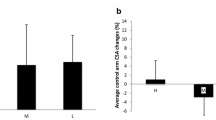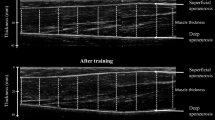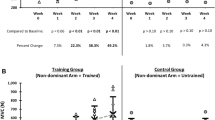Abstract
The effects of maximal effort strength training with different loads on maximal strength, muscle cross-sectional area, the load-power and load-velocity relationship were investigated in the elbow flexors. Physical education students were matched into three groups; G90 (n = 9) trained with a load of 90%, G35 (n = 11) with 35%, and G15 (n = 10) with 15% of 1RM (1 repetition maximum). Training consisted of three to five sets, performed three times a week for 9 weeks. Each set consisted of two, seven and ten repetitions in G90, G35 and G15, respectively. Training was performed with the nondominant arm, and the dominant arm served as control. The 1RM increased 15.2 (SD 4.5)% (P < 0.001) in G90, 10.1 (SD 5.9)% (P < 0.001) in G35 and 6.6 (SD 7.9)% (P < 0.05) in G15. The increase in G90 was significantly larger than for G15 (P < 0.05). In the untrained arm, 1RM also increased for G90 and G15. In contrast to G90, G15 showed a similar increase in 1RM in both arms. Cross-sectional area of the elbow flexors did not change for G90 and G15, while G35 increased 2.8% (P < 0.05). Maximal power and velocity were tested at 2.5 kg and at 15%, 25%, 35%, 50%, 70% and 90% of pretraining 1RM. Power increased for all tested loads in G90 and G35, and G15 showed an increase in power at 15%, 25% and 50% of 1RM. No significant differences in increase in power could be found among the three groups at loads equal to or less than 50%, but at 70% and 90% of 1RM the increase was larger for G90 and G35 than for G15 (P < 0.05). The G35 showed a similar increase in power at all loads tested whereas G90 showed load specificity in the effect of the training. There was a correlation between 1RM and maximal power (r = 0.93, P < 0.0001), and between 1RM and power at load 2.5␣kg (r = 0.73, P < 0.0001). In conclusion, training with loads of 15% and 35% of 1RM resulted in an increase in 1RM. Although the increase in maximal power after training at 90% of 1RM showed some load specificity, it also increased maximal power at 15% of 1RM. Training at loads near maximal power output would seem to increase power efficiently over a wide load range. The high correlation between 1RM and maximal power at load 2.5 kg also would indicate that maximal strength is important for performance at light loads.
Similar content being viewed by others
Author information
Authors and Affiliations
Additional information
Accepted: 2 October 1996
Rights and permissions
About this article
Cite this article
Moss, B., Refsnes, P., Abildgaard, A. et al. Effects of maximal effort strength training with different loads on dynamic strength, cross-sectional area, load-power and load-velocity relationships. Eur J Appl Physiol 75, 193–199 (1997). https://doi.org/10.1007/s004210050147
Issue Date:
DOI: https://doi.org/10.1007/s004210050147




